Join KS2 teacher Sarah Farrell as she explores effective strategies for teaching Year 4 English. This guide covers reading comprehension, grammar, punctuation and writing skills, while highlighting common misconceptions and sharing practical tips and resources to help pupils become confident, accurate writers...
By the time we're teaching Year 4 English, we expect children to have a solid grasp of sentence structure. They should be ready to expand their writing using a range of techniques, many of which build directly on learning from Years 2 and 3. The aim is to get them writing more precisely and coherently.
Understanding the Year 4 English curriculum
Expanded noun phrases
In Year 2, we teach children to use adjectives to form expanded noun phrases (the blue flowers). Year 3 involves learning to use prepositions and preposition phrases in the context of expressing time and place (He sat down beside the river.)
In Year 4 English, we build on this by introducing preposition phrases to add further detail. Pupils learn the vocabulary of ‘determiner’ and how to expand noun phrases using preposition phrases (the green backpack with purple straps).
Improve your subject knowledge by watching this excellent video from primary English consultant Rachel Clarke, which explains how to teach expanded noun phrases. It's taken from Plazoom's Teaching Tricky Grammar CPD unit.
One simple strategy for teaching and embedding expanded noun phrases is to display a picture of different versions of the same objects (e.g., a variety of hats or a Where’s Wally? picture).
Children can take it in turns to choose and describe an object using an expanded noun phrase (e.g., a tall, blue hat with a flower in the band). Their partner has to select which one is being described.
Common misconceptions about expanded noun phrases
A common misconception when creating expanded noun phrases is to write them as complete sentences, e.g., The dark clouds above the forest.
To avoid this, it is important to model creating expanded noun phrases without using capital letters and full stops. This shows that they are not stand-alone sentences.
In creative writing, show children how to take a grammatically correct sentence and add detail to existing nouns.
For example, show children the following sentence: A cat ran across the road. Then model identifying the determiner (A) and the noun (cat), before adding an adjective to describe the cat.
Next, model adding a prepositional phrase following the noun, creating an expanded noun phrase within the sentence (e.g., A small cat with white paws ran across the road.).
Another common error, possibly arising from confusion with fronted adverbials, is incorrectly placing a comma after the expanded noun phrase (e.g., A small cat with white paws, ran across the road.)
Avoid this through careful modelling. Explain that we don't need a comma because the expanded noun phrase is part of the clause.
This sentence builder game will develop Year 4 pupils’ use of expanded noun phrases in their sentences.

Plural possession
The Year 4 English curriculum builds on the use of possessive apostrophes. In Year 2, children learn to use an apostrophe for singular possession (the child’s car). We expand this in Year 4 English to include plural possession (his parents’ friends).
Common misconceptions about plural possession
One difficulty that can arise in this topic is identifying whether something belongs to one or more than one subject.
Using irregular plurals is also an area that children can find difficult. They have to know the plural form and then correctly punctuate it by adding an apostrophe and an -s, e.g., showing ‘the eggs that belong to more than one goose’ as the geese’s eggs.
This bingo game is a fun way to support pupils in Year 4 to revisit using an apostrophe to show singular or plural possession. Pupils will identify whether phrases contain an example of singular or plural possession. The activity includes examples of both regular and irregular plurals.
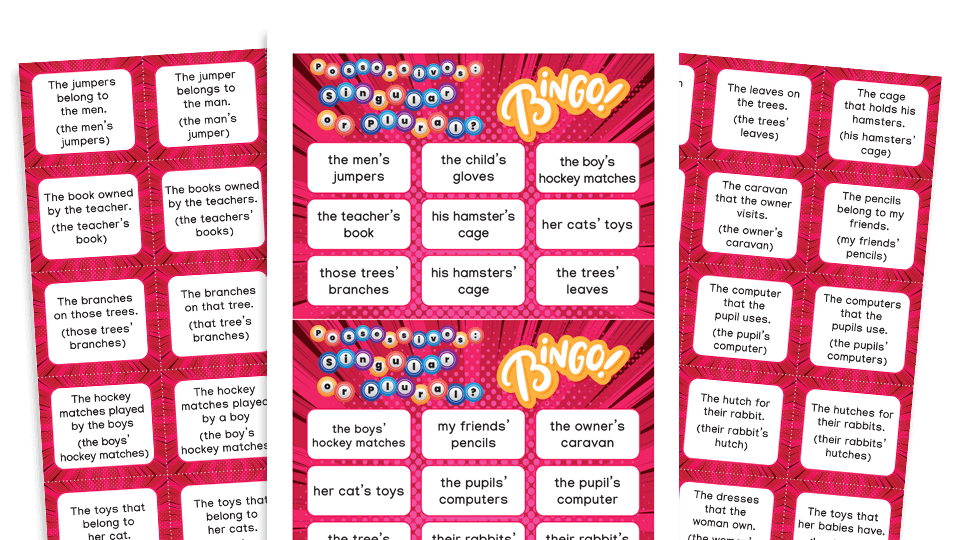
Cohesion and fronted adverbials
After learning about grouping related content into paragraphs in Year 3, you'll teach children in Year 4 to organise ideas and write cohesive paragraphs that have a clear flow.
Using fronted adverbials is one of the main skills you'll teach. These help pupils move the paragraph along in a logical way while also reducing the use of repetitive sentence starters.
Adverbials can have many different functions, such as:
- time (on Wednesday)
- place (in the park)
- frequency (every now and then)
- manner (as quietly as possible)
- degree (quite unbelievably)
It's likely that children have already used many of them in their writing without realising.
Misconceptions to avoid
When teaching children to use fronted adverbials (words or phrases that you place at the beginning of a sentence to describe the following action), there are several possible misconceptions.
Firstly, children may think that a fronted adverbial can exist as a complete sentence. They may write something like this: On Wednesday morning. The children woke up.
Secondly, if they don't understand that we add fronted adverbials to complete sentences, children may add commas in unnecessarily, e.g., The children, couldn’t believe their eyes.
Another possible misconception relating to a lack of understanding of clauses may arise when children start a sentence with a fronted adverbial, but do not have a clear enough understanding of main clauses to end it accurately, e.g. Near the river, was a duck.
As ‘was a duck’ is not a grammatically correct sentence, they should instead write Near the river, there was a duck.
A final error that children make when they are editing their writing is not identifying the full fronted adverbial before inserting the comma, e.g., Luckily, for them it stopped raining.
In this example, the fronted adverbial is ‘Luckily for them’, but the comma has been incorrectly added too soon.
To avoid these potential pitfalls, it's important to model writing a complete sentence and then adding a fronted adverbial to describe the action.
It's also important to model reading through the sentence afterwards and showing children how to check that their sentences still make sense.
This Year 4 fronted adverbials resource pack provides everything that you need to successfully explore fronted adverbials and how they are punctuated.

Speech punctuation
The final main area of the Year 4 English curriculum is the development of speech punctuation. In Year 3, children learn to use inverted commas to punctuate direct speech.
We build on this in Year 4 to include the use of other punctuation to indicate direct speech (such as commas after the reporting clauses) and the use of other punctuation to end the speech.
It's important to show children different structures of speech and help them understand that the reporting clause can be in different places.
“Hello,” said Mia.
Mia said, “Hello.”
The reporting clause can also be placed within the speech. The punctuation rules here will be different depending on whether the reporting clause is interrupting one speech sentence or between two speech sentences.
Interrupting one sentence: “That,” said Amy, “is the most delicious cookie I have ever eaten.”
Between two sentences: “That was delicious,” said Amy. “Please may I have another one?”
One way to help children become confident and fluent with speech punctuation is to provide them with a panel from a comic strip featuring a speech bubble. Ask children to write out the speech using speech punctuation and adding in a reported clause.
As a challenge, repeat the activity with blanked out speech bubbles so children can create their own speech. This enables them to take clues from the context of the picture and be creative about what the characters might be saying.
Pitfalls and errors to avoid
When teaching speech punctuation, it is essential to be aware of the below misconceptions. This way, you can pre-empt them in the lesson through careful modelling, ‘spot the mistake’ activities and highlighting common errors.
- Using either a full stop or no punctuation to separate the reporting clause with the spoken speech. For example, “Thank you” said Leon. / “Thank you.” said Leon.
- Placing the punctuation outside of the inverted commas, e.g., “What shall we do”? asked Maddie.
- Confusion with how to end speech where the reporting clause is introducing the speech sentence. For example, Laura said, “That’s my bottle,”.
- Incorrectly using two reporting clauses to sandwich a speech sentence, e.g., Mark said, “It’s raining,” he said.
- Separating two speech sentences into separate sets of inverted commas, e.g. “It’s raining.” “We should take an umbrella,” said Polly.
- Incorrectly capitalising the first word of the reporting clause when it follows the speech sentence. For example, “That’s mine,” Said the boy.
- Not capitalising the first letter of the speech sentence, e.g. Megan said, “my dog is called Spot.”
- Lack of understanding about the purpose of speech punctuation. This can lead to confusion over what needs to be contained within the inverted commas. For example, “That’s strange said the boy.”
This punctuating direct speech resource pack provides everything you need to teach a series of five lessons in Year 4, culminating in an extended writing task where children use their grammatical understanding in context.
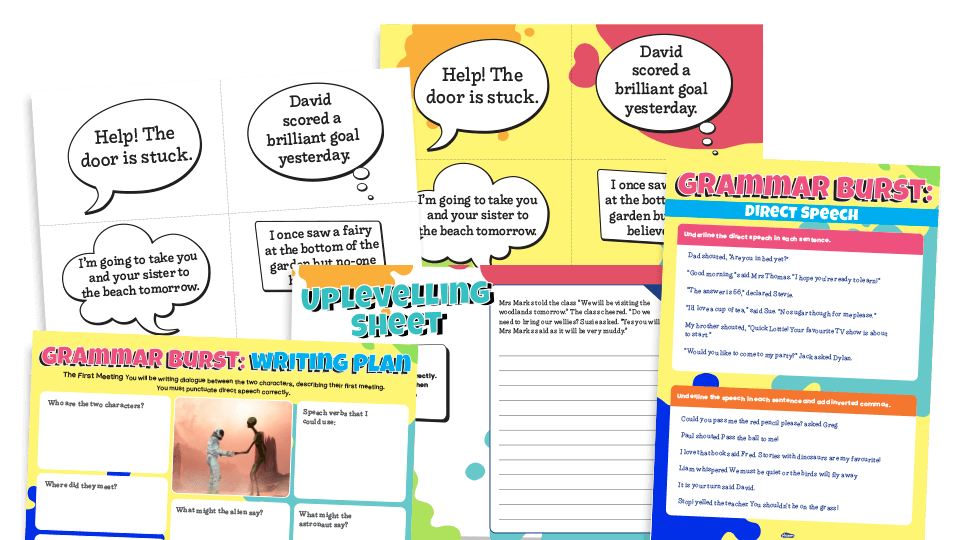
Reading comprehension
In Year 4, children will also continue to develop their reading comprehension skills. This includes making inferences about characters’ feelings, thoughts and motives, and justifying these with evidence from the text.
They will also use details from what they have read to both summarise the main ideas in a text and make predictions about what might happen next. This is alongside explaining the meaning of words and the effect of vocabulary choices.
To support the development of reading skills in Year 4, use Plazoom's Real Comprehension resources for Year 4. These feature a range of reading units based on exciting original texts and give children an opportunity to develop inference and retrieval, build rich vocabularies, identify themes and compare fiction, non-fiction and poetry texts.
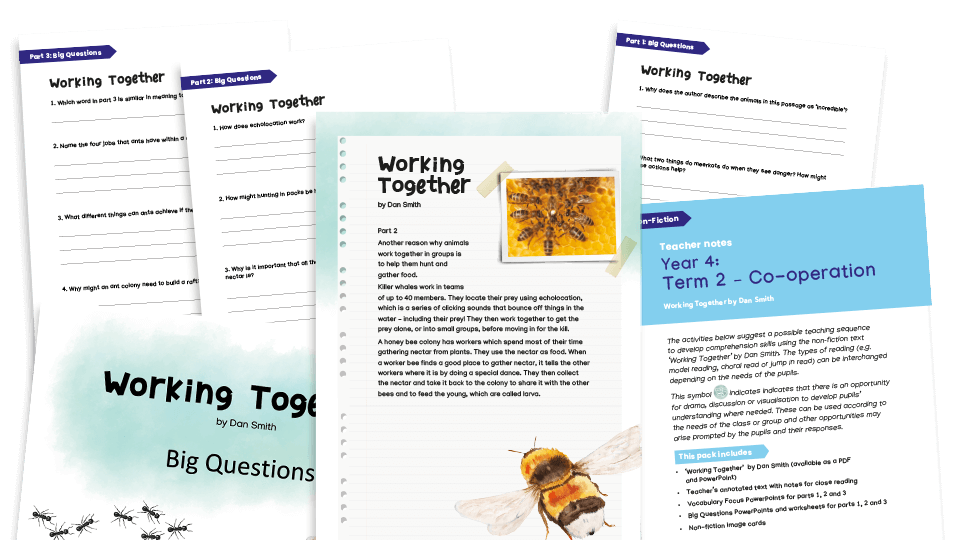
Key teaching strategies for Year 4 English
At the start of the year, ensure that all Year 4 children know how to construct simple sentences. This includes identifying and correcting run-on sentences and comma splices.
Without this knowledge, it's difficult for children to understand and use the writing skills they need to have by the end of KS2.
Teaching grammar in Year 4 English
One thing that some teachers struggle with is how to teach grammatical concepts in Year 4 English.
We need pupils to understand the skill and also to be able to show it in their writing. This can mean that you try and introduce a completely new concept in a writing lesson and expect children to be able to use it in a piece of writing by the end of the lesson.
There are several issues with this approach. One lesson is often not enough time is given for children to be able to become confident with the skill in isolation. This means it's likely that they will use the skill inaccurately.
Their piece of writing may feature the grammar concept you are teaching very heavily, possibly at the expense of other grammatical skills.
Also, the cognitive overload of composing a piece of writing while also consciously trying to include lots of examples of a new skill is unlikely to lead to the best piece of writing.
Fun tasks, games and activities
When introducing a tricky grammatical concept to your Year 4 class, it's important to ensure that pupils have a chance to explore it, try it out and practise using it as a stand-alone skill before trying to apply it to a piece of writing.
This is where Plazoom's Real Grammar Year 4 resources come in handy. For each grammar objective, there are plenty of short, fun tasks, games and activities to give children the chance to fully understand their new learning before starting to compose a piece of writing.
Topics covered include using fronted adverbials, using the possessive apostrophe with plural nouns, using and punctuating direct speech and more.
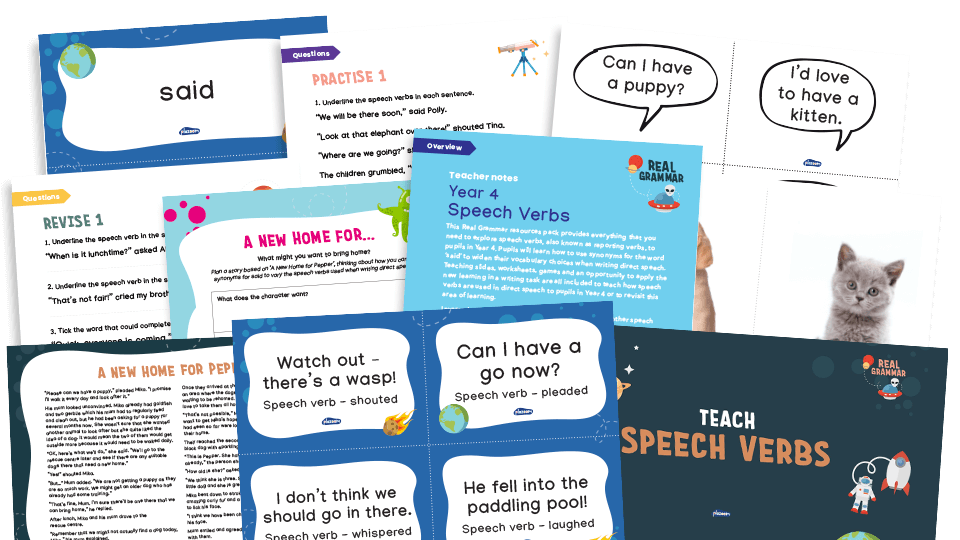
Alternatively, Plazoom's Real Writing Year 4 resources immerse children in expertly-written model texts that explore different grammatical skills in context. Pupils will then apply their learning to a final piece of writing.
For example, this formal letter WAGOLL about saving an ancient woodland covers the suffix ‘-ous’, using fronted adverbials, organising paragraphs around a theme and much more, all in context.
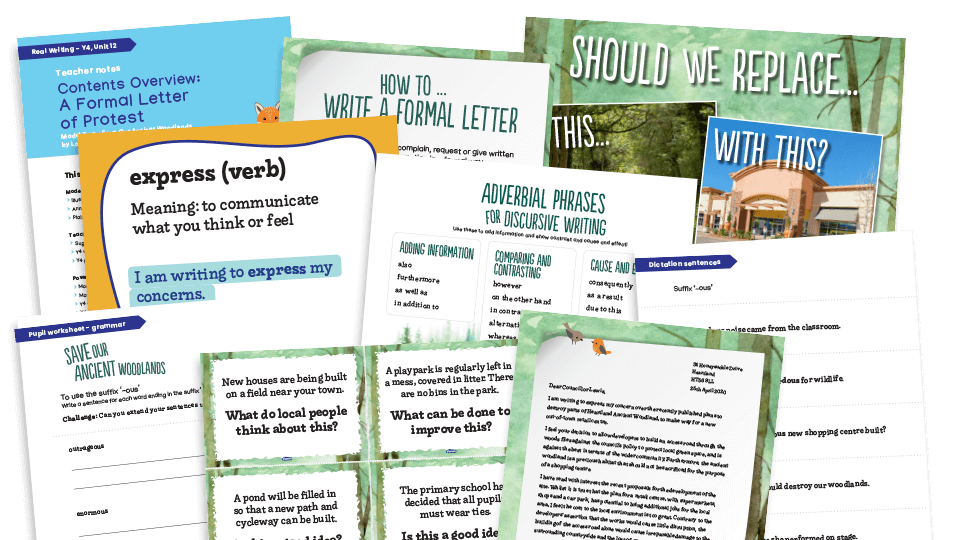
Regular recaps
To help pupils retain the grammar knowledge they learn in Year 4 English, it's important to regularly recap what you have taught.
For the most success, recap skills shortly before pupils need them again so the knowledge is fresh in their minds.
Use regular quizzing, matching games, ‘correcting the mistakes’ activities and entertaining examples to help children feel confident with grammatical concepts.
This can help to act as a ‘pre-teach’ for children who struggle with grammar learning. Use revisiting time to check in, re-teach the concept and see how many children will need support.
Adaptive teaching
It is likely that there will be children in your class who struggle with some of the grammatical concepts you need to cover.
There are many different ways to adapt your teaching for a mixed-ability class. Try:
- using vocabulary word banks
- providing cloze sentences with empty spaces for children to insert words or phrases
- providing steps to success or worked examples for children to refer to
- using faded scaffolding where support is slowly withdrawn as children become more confident
Sarah Farrell is an experienced KS2 teacher and phase lead based in Bristol. Currently serving as an assistant headteacher and maths lead, she is also the curriculum and pupil premium lead at her school.